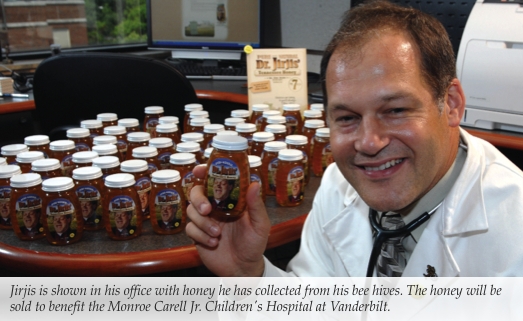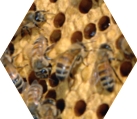Jim Jirjis, M.D., MBA, is in full array. He is wearing a thick, white cotton-polyester full body suit. He has a netted veil over his face and neck, tightly tucked in, and gloves to
protect his hands. The suit makes for a marvelous sight, but these threads aren’t for fashion—Jirjis is a beekeeper.
To Jirjis, the honeybee is one of nature’s miracles. They toil, covering 16 square miles per hive, pollinating many of
our favorite crops—including apples, almonds, pears, blueberries, blackberries and raspberries—and astonishingly, they find the time to make honey.
Jirjis has lassoed 700,000 of these industrious insects, putting them to work
for the Monroe Carell Jr. Children’s Hospital at Vanderbilt. As beekeeper to 14 hives, he expects to produce more
than 3,000 jars of honey each year—and now, Jirjis is selling the honey and donating the proceeds to the Children’s Hospital.
Hobby for a hectic schedule
“One day I was at a meeting at Vanderbilt, where someone was supposed to talk
about some medical condition, and they didn’t show up. So I sat there, me and a bunch of people, and another doctor, John
Cristman, who is a former Vanderbilt pulmonologist. There was a group gathered
around him and he was talking about his beekeeping,” recalls Jirjis. “The speaker never showed up, but almost everyone in the room was enthralled with
the various fascinating aspects of beekeeping.”
Jirjis is 40, and it can be said that he is interested in just about everything.
An internal medicine specialist with expertise in infectious disease, Jirjis
found the biology of beekeeping fascinating.
“I love it because not only is it fun, there is an interesting science to it.”
That science, which includes keeping the hives healthy and free of infection,
came naturally to the doctor.
“It’s really biologically intriguing,” says Jirjis. “In one of my first beekeeper meetings, a bunch of beekeepers were having a
conversation about antibiotics. One beekeeper said, ‘I don’t think that every fall you should be using antibiotics to treat your bees, just
in case they’re infected. You are going to cause antibiotic resistance.’ And another beekeeper responded, ‘I don’t care, my bees aren’t going to suffer.’ What does that sound like? It sounds like the modern day
medical-doctor-over-treating-with-antibiotics-creates-resistance story, but it
was a bunch of beekeepers talking about it.”
As a professor of Medicine with a busy internal medicine practice, Director of
the Adult Primary Care Center, Chief Medical Information Officer for Outpatient
Clinics, and Assistant Chief Medical Officer for Electronic Medical Records,
Jirjis is as busy as the bees he keeps. Beekeeping proved to be the perfect
hobby for his strained schedule.
“It’s an incredibly good hobby for a busy person because it does not take much
effort. And it’s not that expensive of a hobby to get started with.”
Beekeeping is very different from taking care of other domesticated animals—they need far less attention. In the spring, Jirjis visits the hives weekly; in
July, he harvests the honey; in the fall, he treats the hives for infections;
and in the winter, he does nothing, because if the hermetically sealed hives
are opened, the bees will die from the cold.
“It’s not a domesticated animal… you just create the environment and it does its own thing.”
Bee biology, crop ecology
Over the years, the word “bee” has acquired a stinging connotation. But, for the honeybee in particular, this
is an unwarranted prejudice.
“The honeybee is very docile. Most people confuse yellow jackets, wasps, and
hornets with bees. They say, ‘I got stung by a bee’—but it’s not a honeybee. honeybees very rarely sting you,” says Jirjis.
Beekeepers like Jirjis have fostered this trait by selectively breeding the bees
for a tamer nature. Over the years, honeybee docility has grown to the point
where a visitor can come within a few feet of an open hive and observe—without a bee suit on.
“Before you came out here you never thought you would be standing that close to a
hive, did you?,” Jirjis asks as he works.
Though the honeybee is docile, Jirjis advises visitors to take caution—there are still tens of thousands of bees around, and their hives are being
broken into.
“Stay real slow in your movements. What happens is that you get the willies, and
then you start reacting. That’s the reflex, and then they say, ‘oh, predator.’”
Modern frame hives look like wooden file cabinets with no front doors. They are
divided into sections, which can only be reached by removing the sections
above. Each section is a rectangular box with frames arranged vertically
side-by-side the entire width of the interior.
Honeybees enter and exit their hives by a single opening, flying in a line
parallel to the ground at tremendous speeds (hence the term “beeline”). The bees appear a maelstrom as they enter the hive, but once inside, their
organization is as remarkable and complex as any, say, hospital or medical
center.
After Jirjis pulls the cover of a hive off (which is quite difficult because
honeybees glue the pieces together with a substance called propolis, obtained
from trees), he deftly diagnoses the health of the hive, frame-by-frame.
As he works, he rhythmically releases smoke into the hive using a tin can with a
bellows and spout. The can is full of burning pine needles. The smoke tricks
the bees into thinking that the hive is in danger of being burnt, so they stop
any thought they might have of attacking and gorge themselves with honey in
preparation for relocating the hive.
While he inspects his hives, Jirjis talks nonstop, of the process and science of
beekeeping and of past honey yields.
“I had a horrible year last year… I mean an absolutely horrible year. Almost all of the hives were ruined
probably because of the late frost,” Jirjis says.
Honey yields, however, are the least of Jiris’s worries when a major bee die-off occurs.
“The honeybee is really important to our ecology. Many different flowering
species depend on the honeybee for pollination. For instance, the apple, it was
not indigenous to this country—and neither are many flowering crops that we harvest. Now that they are here,
honeybees have become essential in pollinating them,” said Jirjis. “By supporting this, people are making sure that they still exist.”
But beyond the fact that beekeeping is the perfect hobby for a busy person, that
it is scientifically fascinating, and that it is essential to the environment,
is the idea that Jirjis will be selling the honey for the Children’s Hospital.
“There are so many payoffs for so little effort,” says Jirjis.
The satisfaction that Jirjis gets from beekeeping has spread infectiously to
those around him.
“Three or four people now have joined me in beekeeping. Two of my patients have
taken up beekeeping,” says Jirjis. “I’m hoping in the future there may be more.”
Buzz marketing
Jirjis has launched a Web site—www.jirjis honey.com—where Jim Jirjis Pure Tennessee Honey is sold. In addition, there will be
vendors located at Vanderbilt Medical Center. All of the proceeds from the sale
will be donated to the Monroe Carell Jr. Children’s Hospital at Vanderbilt. Vanderbilt staff and friends aiding Jirjis are
Shanmuga Sundaram, Rich Germano, Steve Dennis, and others. Another key
supporter is Orrin Ingram, who donated land to house many of Jirjis’ hives.













